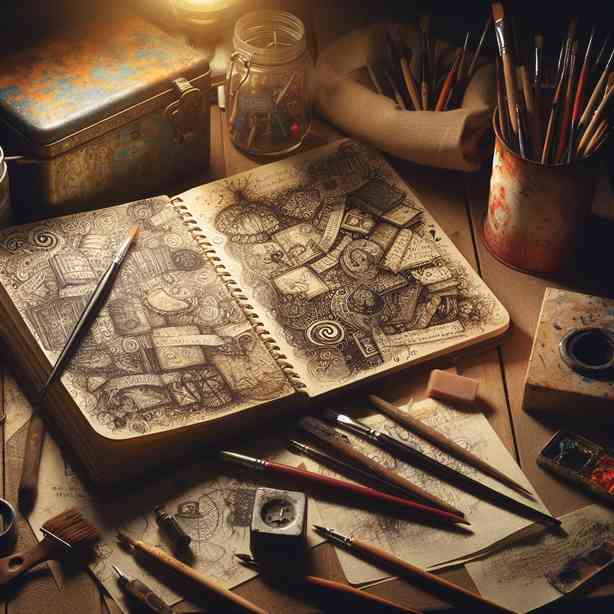
When a sketchbook transforms into a diary, it becomes much more than just a collection of drawings or thoughts. It evolves into a deeply personal space, a repository of emotions, experiences, and reflections that document one’s journey through life. This transformation is often organic; it usually begins with a simple doodle or a fleeting thought and can develop into a vivid chronicle that mirrors the artist’s inner world.
Initially, many people pick up a sketchbook with the primary intention of illustrating their creativity or practicing their drawing skills. The blank pages invite exploration, experimentation, and self-expression, serving as an open canvas where ideas can flow freely. However, as time progresses, individuals often find themselves pouring not just their artistic talents into these pages, but also their thoughts, feelings, and daily experiences. This gradual blending of sketches and writing creates a rich tapestry of personal history.
Sketching offers an immediate way to capture visual impressions while writing can evoke deeper introspective analysis. Each page may hold a vibrant drawing alongside detailed reflections—a meditative space where thoughts can be examined and emotions processed. This coalescence allows individuals to explore the complexities of their emotions; through the act of creating, they begin to understand themselves more clearly. The rawness of sketches paired with the honesty of written word has the power to illuminate aspects of one’s life that might otherwise remain unacknowledged.
As these pages fill, they begin to reflect the ebb and flow of daily life. Memories, snapshots of moments, or even creative ideas coexist with profound insights or mundane reflections on the day-to-day. It can be as simple as depicting the view from a favorite café or drawing the intricate details of one’s home. What starts as art evolves into documentation, capturing both significant milestones and the little moments in between that weave the fabric of someone’s life.
This diary-like quality imbues the sketchbook with sentimental value; each page becomes a time capsule holding memories that resonate deeply with the artist. Nostalgia may wash over you when revisiting these pages years later, allowing you to reflect not just on what you created, but also on how you felt at that moment in time. This emotional timeline can reveal growth, change, struggles, and victories, making the sketchbook a crucial tool not only for artists but for anyone navigating the complexities of life.
Furthermore, a sketchbook diary can serve a therapeutic purpose. Many individuals use this space to work through anxieties, challenges, or emotional turmoil. The process of putting pen to paper—whether it be through drawing or writing—can facilitate healing and help articulate feelings that are difficult to express otherwise. It becomes a private sanctuary where individuals can confront their innermost thoughts without judgment, allowing for clarity and relief.
By integrating personal insights with visual creativity, artists often become more attuned to the intricacies of their surroundings. Every sketch, no matter how simplistic or intricate, captures the essence of a moment valued in time; whether it’s the play of light over a landscape, the joy of friendship, or the pain of a difficult conversation, these experiences can be immortalized in an evocative way. Whether the sketches depict fantastical worlds or ordinary objects, these visual elements bring life to the written word, layering meaning and depth to the entries.
Another essential aspect of blending sketching with writing lies in its capacity to inspire future creativity. Revisiting old entries can spark new ideas or reinterpret previously explored themes, resulting in a cycle of creative potential. A single sketch might lead to an elaborate painting, while a reflection on a past experience could blossom into a series of writings or poetry. The sketchbook diary thus fosters not just personal documentation, but a dynamic crucible of inspiration that feeds artistic growth.
Moreover, sharing this intimate journey—whether through social media, exhibitions, or community groups—can build connections with others who resonate with similar experiences. While the sketchbook is indeed a personal endeavor, it does not have to remain isolated. Through sharing, a sense of community can emerge, fostering discussions around art, emotions, and the intricacies of human experience. This communal aspect can enhance the process, providing external validation and opportunities for collaboration or support.
In conclusion, when a sketchbook evolves into a diary, it transcends its original purpose and becomes a profound tool for self-discovery, creativity, and emotional expression. Each doodle, each word articulates a narrative woven from the artist’s experiences and reflections, capturing the essence of their journey. The combination of sketches and writing nurtures a vibrant dialogue between the heart and mind, ultimately enabling individuals to document their lives while fostering personal growth and connection with others. This transformation offers a unique lens through which to view the world and oneself, making every page a testament to the beauty of life’s everyday moments.


